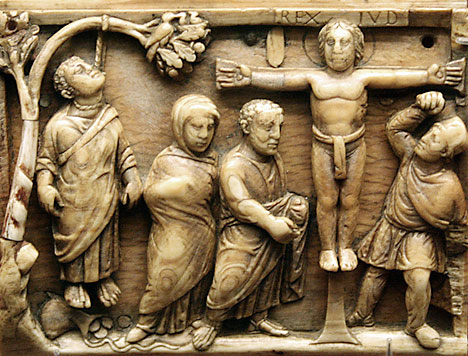One Taken, One Left Behind
“…falling headlong, he burst open in the middle…”
Todd Robinson commented:
“I’ve enjoyed your particular brand of orthodox preterism. Working through Acts recently, I began to wonder what Michael Bull’s take on Acts 1:11 and 3:19-21 would be… Thanks for any insight.”
On Acts 1:11:
Luke works through the matrix, forming the Covenant Head in the first part, a New Covenant Body in the second part, with the death of Judas at the centre being the reason for the apostolic “Day of Atonement” goat drawn by lot, a makeshift Urim and Thummim:
Commandments (Ark – Transcendence)
…..Delegation to Israel (wait for power)
…..(Veiled promise concerning Israel – Hierarchy)
……….Ascension of Christ (Altar) HEAD – flaming torch
……….Ascension of Disciples – upper room (Table)
……………Judgment of Judas–head and body–under the
……………Old Covenant Law as a picture of AD70
……………(Lampstand – Ethics) [1]
……….Witness of Apostles (Incense) BODY – smoking firepot
…..Selection of Matthias for the “first” death (Mediators – Sanctions)
Apostolic Succession granted (Shekinah)
On the Day of Atonement, the High Priest made two approaches, one for the Covenant Head, the priesthood, with the blood of a bull; another for the Covenant Body, Israel, with the blood of a goat, the “first death.” (The second death was the Azal goat, carrying the curses. [2])
Jesus was taken into the glory cloud as Great High Priest, the Covenant Head, not with the blood of a bull but with His own blood.
“Not with the blood of goats and calves, but with His own blood He entered the Most Holy Place once for all, having obtained eternal redemption.” (Hebrews 9:12)
He would return from “behind the Veil” for the second approach. “So that where I am, you may be also.” He would receive them to Himself to complete the sacrificial ascension of Israel, Head and Body, Adam and Eve, and celebrate the marriage supper, the “rest” for the Old Covenant faithful. [3] This structure is laid out in the ascension offering in Leviticus 1. Notice that we see this predicted in Daniel 7. Jesus is already on His throne, and “one like the Son of God” ascends to be with Him. This interpreted later in the chapter to be the saints inheriting the kingdom. They see Him because they are like Him. [4]
On Acts 3:19-21:
I think verse 25 is the key, the “blessing of all nations” promised to Abraham. The Restoration was prefigured by Israel’s restoration from Babylon. But then, this first century restoration, at the end of the Old Covenant, was the end of that social divide. The end of the New Covenant will be the end of the Creational divide, an even greater restoration. History is chiastic. The judgments are: Physical / Social / Personal / Social / Physical. [6]
But I think, judging by Peter Leithart’s excellent exposition of 2 Peter, that Peter had AD70 in mind. [7] The prophets always preached for the purpose of a moral response in light of a coming judgment, i.e. be the good (repentant) goat, not the bad one.
____________________________________
[1] See Fool’s Gold. It’s interesting that Judas is lifted up in the gospels and “deposed” around Pentecost, just like Satan, and just like the Herods. Notice that Abraham’s sacrifice had the holy birds as undivided head, and animals as divided (Jew-Gentile) body. (See Pass-over and Pass-through). Jesus’ and Judas’ bodies were both divided and emptied, but filth came out of Judas (like Eglon) and living water came out of Jesus. Jesus left the burial linen arranged in the same manner, head and body. The Covenant Head was not crushed.
[2] See The Second Death.
[3] See The End Is Not Yet.
[4] See High As the Horses’ Bridles.
[5] See James Jordan’s exposition of this in his Daniel commentary. The structure of Daniel 7 follows the same pattern as the Levitical Atonement rite, with the fragrant saints caught up in “clouds” prefigured by the incense.
[6] See A New Heavens and a New Earth.
[7] See How To Read the New Testament.



























July 14th, 2011 at 10:55 am
Mike: You write: ‘The prophets always preached for the purpose of a moral response in light of a coming judgment, i.e. be the good (repentant) goat, not the bad one.’
Please expand on this?
Thanks!
Chuck
July 14th, 2011 at 11:00 am
Chuck
It means that the prophecies of the prophets did not primarily concern events that were far off (except for the basic outlines of succession arrangements at the end of their Covenant lawsuits, such as the 1000 years in Revelation.) Their warnings always concerned imminent judgments, so the apostolic warnings are the same. Not only do they look imminent, they follow in a long tradition of prophetic imminence.
If your question concerned the goats, it’s like the atonement vision in Ezekiel 8 and 9. Only those who mourned for sin, personal and corporate, were redeemed. The Sanctions divide true and false Covenant oaths, sheep and goats, bride and harlot.